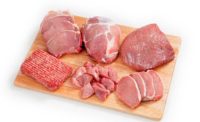Ingredients
Moving toward natural antioxidants in meat and poultry products

The latest development for antioxidant ingredients used for meat and poultry products is a better understanding of how the animal proteins spoil and the development of antioxidant combinations for superior shelf-life extension.
“Fresh meat sausages are made from fresh comminuted meat from different sources, such as pork, chicken and beef, and are high in fat and, therefore, highly perishable even when refrigerated in oxygen semi-permeable packaging,” says Kantha Shelke, food scientist and principal of Chicago-based Corvus Blue, a food science and research firm. “Lipid oxidation, microbial growth and enzymatic autolysis, including proteolysis and lipolysis, are the three main mechanisms of spoilage with microbial growth as the predominant cause of spoilage for sausages.”
A natural blend of rosemary extract and buffered vinegar helps retain the color of sausages even after 14 days of refrigerated storage, inhibit growth of spoilage bacteria and deter lipid oxidation level, Shelke explains. Similarly, a blend of rosemary extract (0.5 percent) combined with buffered vinegar and rosemary extract (0.2 percent) combined with green tea are as effective in prolonging the shelf life of fresh sausage as are synthetic antioxidants such as BHA and BHT (0.02 percent based on fat content).
In addition, Americans shoppers associate redness with meat freshness. “Modified atmosphere packaging (MAP) is used extensively to preserve meat color and meat processors are finding that incorporation of rosemary extract alone could further improve the color and flavor stability of fresh meats packed under MAP condition,” Shelke says.
Antioxidant combinations are particularly growing in meat and poultry products. For example, rosemary and acerola extracts, rosemary and vinegar, rosemary and green tea extract along with rosemary and cranberry extract are growing in popularity for extending shelf life and also providing additional color and flavor stability compared to rosemary extract alone.
“These are becoming popular because of the health halo and clean label halo that these antioxidant-rich ingredients carry for clean label conscious shoppers,” Shelke says.
Wes Schilling, a professor of food science in the Department of Food Science, Nutrition and Health Promotion for Mississippi State University, agrees with Shelke’s assessment. He says for the past several years the latest developments include evaluating natural antioxidants for their ability to replace synthetic antioxidants and including natural antioxidants in an ingredient blend that is used to replace the functionality of phosphates in meat applications.
In turn, a lot of natural flavors such as rosemary, green tea, oregano and cherry powder are being used. Processors also have tried including plum puree, grape seed extract, pomegranate extract, cranberry extract, sage, chitosan and cloves.
“Rosemary, green tea, oregano, cherry powder and chitosan are all growing in use because they are able to extend product shelf-life in many applications,” Schilling says.
Meeting expectations
While growing interest in naturally sourced ingredients is propelling the use of antioxidants to maintain the color and flavor stability of processed meat, processors are struggling with matching the antioxidants with the applications.
“Gone are the days of mindlessly adding multifaceted, idiot-proof synthetics that worked across a wide range of meat and poultry products,” Shelke says. “It is now time for formulators and processors to understand the mechanism of spoilage and optimize the antioxidant mix for the relevant functionality.”
For example, fermented sausage formulas generally contain 45 percent meat block and 42 percent fat with a 1.6:1 ratio of moisture to protein, a pH less than 5 and about 4 percent salt by weight. “Such fatty sausages, preferred by Americans, also tend to be highly susceptible to oxidation because of their high fat content, especially when sliced and not stored under a protective atmosphere,” Shelke explains. “Formulators have to find the appropriate antioxidant blend and also the optimized amount, so the product is adequately protected and not too much is used to affect taste and most of all cost.”
The clean-label alternative to sodium nitrite or potassium nitrite that was used at 156 parts per million (ppm) to stabilize cured meat flavor and color and to deter growth of anaerobic microbes is plant-based natural cures with approximately 150 ppm sodium nitrite from pre-converted vegetable juice powder, 0.12 percent of acerola powder, rosemary and green tea extracts. “The challenges here are to standardize every batch of ingredients for nitrite content because of the intrinsic variation in agricultural crops,” Shelke says. “Standardization means additional testing, and the cost is carried over to formulators. Formulators also have to make sure that they get a fresh batch of ingredients each time because these tend to diminish in reactivity with storage.”
Schilling says challenges for processors include achieving similar antioxidant effectiveness with natural antioxidants than what is seen with synthetic antioxidants. In addition, the cost effectiveness of using natural antioxidants can be problematic. Finding an antioxidant to be included in blends of ingredients that are used as phosphate replacers also remains a challenge for formulators. He believes work will continue on finding natural antioxidants that can replace the antioxidant effect of phosphates when they are removed from formulations for cleaner labels.
Moving forward, Shelke expects consumers will want foods to be as plant-based as possible because of the health concerns of the effects of synthetics. She says to watch the pipeline for the following ingredients (along with their active ingredients):
- Oregano essential oil with thymol, para-cymene, gamma-terpinene and carvacrol;
- Sage essential oil with eucalyptol, camphora and alpha-pinene;
- Curry, mint leaves, grape seeds and peels extracts, borage leaves extract, sea buckthorn (berry residues) for their phenolics;
- Rosemary and oregano leaves extracts for phenolics, rosmarinic acid, carnosic acid and carnosol;
- Defatted canola meal for sinapic, ferulic and para-hydrobenzoic acid; and
- Red grape pomace extract and cranberry pomace extract for polyphenolics and anthocyanins. NP
Looking for a reprint of this article?
From high-res PDFs to custom plaques, order your copy today!









